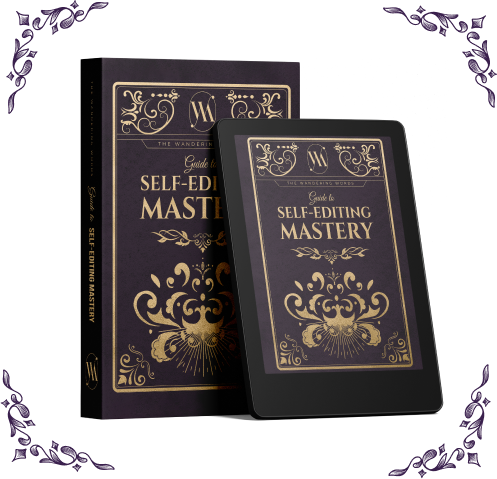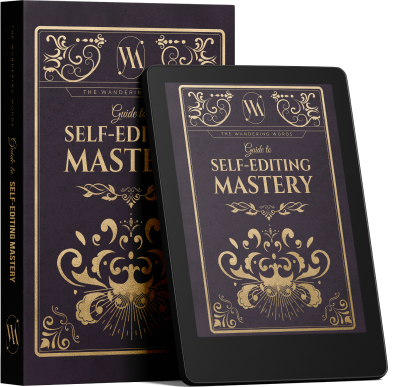Our Guide to Self-Editing Mastery has helped thousands of authors just like you:
- Pre-edit their books with ease
- Avoid the most common writing errors
- Quickly identify spelling & grammar mistakes
- Be more prepared for professional editing
Our Guide to Self-Editing Mastery has helped thousands of authors just like you:


We’ve all seen dialogue tags in writing—they’re more prevalent in fiction but still present in nonfiction. Have you ever really paid attention to them, though?
If not, that’s great. They’re not meant to be noticed! If written poorly, they can pull the reader out of the story and clog up the writing with unnecessary wordiness. But when written correctly, dialogue tags will aid in comprehension and the conveyance of emotion and tone, not break up the flow.
To ensure readers aren’t broken out of your own story, dialogue tags are worth a closer look.
Simply put, dialogue tags are used to tell the reader who is speaking, and sometimes the manner in which they are doing so.
There should be a new line of dialogue for each speaker (see “New Speaker, New Paragraph” for more on this), and the dialogue tag will be attached to the appropriate line.
For example:
“Where are you going?” asked my mother.
“To school,” I replied in an irritated tone. “Where else would I be going right now?”
Dialogue tags can come before dialogue, after, or in the middle, and they are introduced by commas (except in the case of question marks or exclamation marks ending the dialogue).
Using dialogue tags at the end of a sentence:
“You’re the best thing that ever happened to me,” he said softly.
“How did you do that?” she asked.
Examples of dialogue tags at the beginning of a sentence:
I shouted, “Hey! Over here!”
Abby said, “That’s enough.”
Examples of dialogue tags in the middle of a sentence:
“These instructions look complicated,” I said as I frowned down at the paper. “This might take more than one afternoon.”
“I’m glad you are so happy!” Cade said. “I know we haven’t talked in a while. We should definitely get lunch more often. I’ll look at my schedule right now. When are you free in about two weeks?”
“Rita,” my father said, “you can’t leave without eating breakfast.”
One thing to remember when placing the dialogue tag in the middle is to make sure the tag still comes after the first line of dialogue so that the reader doesn’t have to read through a paragraph of dialogue before they know who is speaking.
Notice in the case of the last example that the sentence of dialogue wasn’t finished, so the tag is surrounded by commas.
Actions can be joined with dialogue tags using commas.
Examples of dialogue tags with an action:
“Hey,” she said, looking up.
“I thought I saw you over there,” I said, giving him a smile.
This being said, read on to the next section.

The general rule: if it can stand alone as a sentence, it’s not a dialogue tag. Actions are great replacements for dialogue tags; they cannot be used as tags themselves.
Notice this rewritten line from one of the examples above:
“To school.” I rolled my eyes. “Where else would I be going right now?”
As an eyeroll is an action conveying the character’s irritation, there are periods separating it from the dialogue rather than commas attaching it to the dialogue. Nodding, crossing one’s arms, stepping forward, gulping, etc. are all actions that need to be separate from dialogue.
The same is true with facial expressions (smiles, smirks, frowns, etc.):
“To school.” I scowled. “Where else would I be going right now?”
“Excellent.” Tim smiled. “When should we get started?”
“I miss him.” Her eyes seemed far away.
Describing a tone of voice isn’t a tag either:
“I thought I had apologized.” Her voice wasn’t exactly warm, but it wasn’t cold either.
Dialogue tags aren’t always needed. In fact, using too many of them can make your dialogue clunky. Determining when to use them depends on how many characters are in the scene. In the first example in this post, we have two characters: the mother and her child. As long as a starting point has been established and the lines alternate, some of the tags can be omitted.
“Where are you going?” asked my mother.
“To school. Where else would I be going right now?”
“You don’t have to take that tone with me.”
Of course, doing this for a long period of time or with a scene including many more characters might mean the reader will lose track of who is speaking—especially when there is little to no context for tone or behavior. The easiest way to make dialogue interesting and easy to imagine is to use a combination of dialogue tags, action, and lines without tags.
“Where are you going?” asked my mother as she gave me a look.
“To school.” I rolled my eyes. “Where else would I be going right now?”
“You don’t have to take that tone with me.”
I paused with my hand on the doorknob and mumbled, “Sorry, Mom.”
This dialogue is much more engaging, as the actions and expressions still tell the reader who is speaking but make the scene more dynamic.
Reading, “he said,” “she said,” over and over is not pleasant, but purposefully trying to vary every dialogue tag (“he uttered,” “she voiced,” “he whispered,” “she blurted”) to avoid “said” will also make for an odd reader experience.
It is helpful to use dialogue tags other than “said” sometimes, especially when a certain manner of speaking needs to be conveyed. Some examples of this: remarked, told, explained, protested, replied, answered, whispered, and ordered. To really bring a scene to life, think of tone (matter-of-fact, pointedly, hurriedly), volume (shouted, whispered, muttered), quality (raspy, whiny, dark), and emotion (happily, angrily). Some of these will need to be added to “said” but will still help breathe life into a scene and avoid constant “he said,” “she said.”
As discussed, to make a scene more dynamic, remove some dialogue tags altogether when it is clear who is speaking, and add in some actions in place of the tags. The placement of the tags can also be varied a bit so not all of them are placed at the end of dialogue strings.

Our last order of business is to consider the reality of the dialogue tag and the effect the words you choose will have on the reader.
There are certain actions that would be really odd to do while speaking, such as drawing in a breath or holding it. And there are actions that can coincide with short dialogue but not more than a few words. For instance, you can sigh out a word or a couple, but likely not two whole sentences—same with groaning and laughing.
Think: Realistically, would this happen? Is it going to take the reader out of the story?
When in doubt, act it out! For example:
“I didn’t think so. I was hoping, but I knew deep down it wouldn’t be possible,” she sighed.
Try sighing out that entire two sentences. By the end of it, you’d likely be out of breath, so this isn’t something that would happen naturally. In this instance, either replacing sighed with said or another dialogue tag, moving the tag to between the two sentences so the character is only sighing out the first sentence, or adding a period at the end of the dialogue and making the sigh stand on its own after the dialogue (which would change the action of the scene a little, so consider carefully) would make this more realistic.
“I didn’t think so. I was hoping, but I knew deep down it wouldn’t be possible,” she said.
“I didn’t think so,” she sighed. “I was hoping, but I knew deep down it wouldn’t be possible.”
“I didn’t think so. I was hoping, but I knew deep down it wouldn’t be possible.” She sighed.
The way we structure dialogue tags can hinder or enhance the reader’s experience. Introduce dialogue with a new line for each speaker and a tag that shows who is speaking; keep in mind the placement of the tag and the commas that introduce or follow; remember that actions and descriptions are not dialogue tags; use actions and omit or vary tags to make your dialogue more dynamic; and consider the reality of your word choice when it comes to dialogue tags.
You’re now equipped to create or refine engaging strings of dialogue with seamless dialogue tags. Write on!

